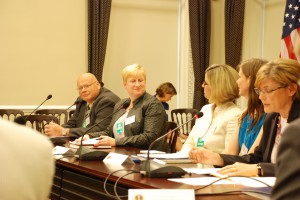By wademelton, July 16 2014
On June 10, 2014, I had the honor and privilege to be invited to present at an invitation only summit focused on “Ensuring Positive Futures and Academic Success: Student Substance Use and Educational Success” hosted by Acting Director Michael Botticelli and Deputy Director David Mineta, of the Office of National Drug Control Policy Executive Office of the President, and Deborah S. Delisle, Assistant Secretary for Elementary and Secondary Education, United States Department of Education.
 This day long event was held at the Eisenhower Executive Office Building in Washington D.C. Additional guests engaging in this national debate included leaders from OJJDP, SAMHSA, NIDA, ACF, NIH, Department of Defense, Department of Agriculture, legislative aids, researchers, and many others from around the nation, including Reclaiming Futures National Executive Director, Susan Richardson.
This day long event was held at the Eisenhower Executive Office Building in Washington D.C. Additional guests engaging in this national debate included leaders from OJJDP, SAMHSA, NIDA, ACF, NIH, Department of Defense, Department of Agriculture, legislative aids, researchers, and many others from around the nation, including Reclaiming Futures National Executive Director, Susan Richardson.
The story I shared was about Hardin County and how the Reclaiming Futures six-step model is integrated into our work system wide. Our story is about intentionally transforming our local juvenile justice system to go way beyond probation supervision and accountability.
The court has implemented validated screening and assessment tools, evidence based treatment models, brought a school on site, and cross-trained staff so everyone (academics, treatment, probation, and judge) speaks the same language.
Some of our best assets are community engagement and stakeholder development. Ohio Northern University, a local university, provides student teachers to help our students with their academic deficiencies, interns to work with our justice kids, and faculty and staff helping with evaluation and support. Our community stakeholders provide internships, job shadowing possibilities, health education, financial literacy education, and financial support (donations and event support).
During my presentation at the summit I shared GAIN data showing a significant reduction in substance use among our justice kids. This data shows:
- Our justice kids have gone from substance use of 14 or more days per 90 days to 80% who are no longer using at 12 months post intake,
- Those who are still using are using less than once a week, and
- The risk level for continued illegal activity among our justice kids has dropped from mid-high to low.
More Treatment…Better Treatment…Beyond Treatment is the best way to explain the results.
Our students are 100% of the 15% - 25% that do not pass in their local schools (the minimum benchmark for student testing is that 75% of sophomores and 85% of juniors and seniors should pass the state’s battery of tests). Academically, over 97% of students who enroll at Hardin Community School are in poverty. These students have chronic behavior issues, are chronically truant, have been suspended and/or expelled, and are at least one full year behind their class. While most of our students do not graduate on time, more often than not, they graduate. Our graduation rate is over 95% with 59 of 62 students graduating since 2010.
We know if we can keep kids clean, address their mental health and AOD needs, and make sure they are in school, their chances of experiencing academic success are great.
Hearing a mom at a graduation ceremony, with tears in her eyes, say to her daughter, “I am so proud of you…you are the very first person in our family who has ever graduated,” keeps us doing what we do every day in the trenches.
Like most in the juvenile justice system, in Hardin County we provide intervention services that help stabilize our kids’ lives. In doing so, we also strive to prevent continued and future use in the current generation and hope this in turn impacts the generations to come.
There are many times that I think we are one hundred miles wide but only a half-an-inch deep. At the summit, I urged those at the table to share their research, their tools, and their resources with the grassroots. We have a passion for this work, but often lack the tools. I asked them to find a way to help us become much deeper than we are wide.
Updated: July 16 2014
